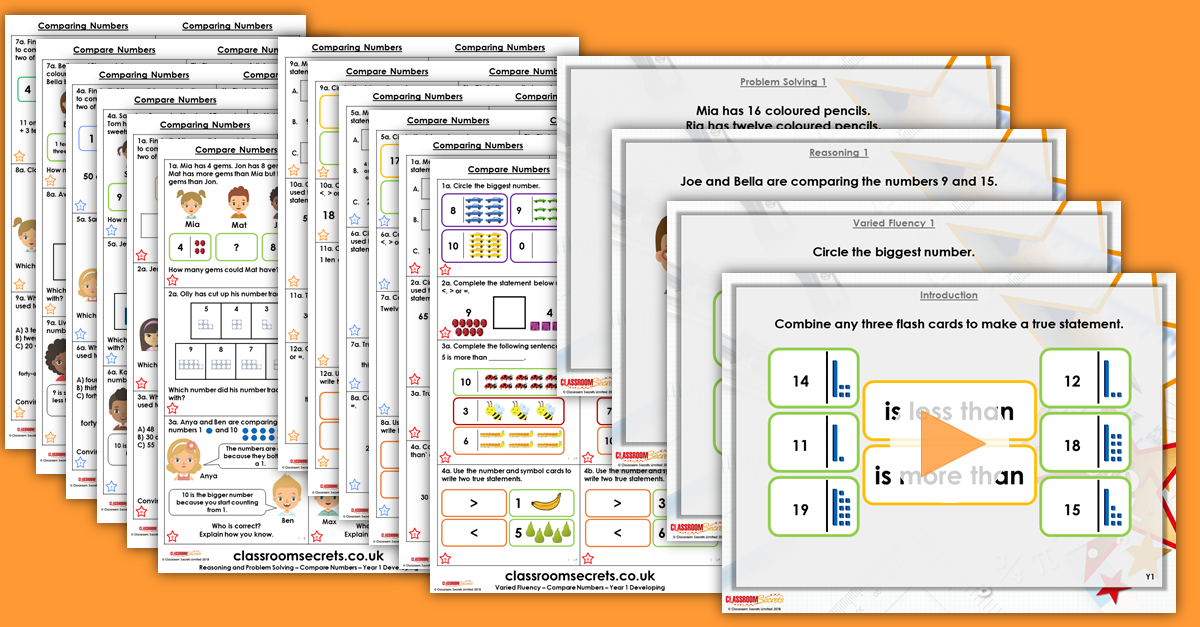Mixed Age Year 1 and 2 Place Value Step 8 Resource Pack

Step 8: Mixed Age Year 1 and 2 Place Value Resource Pack
Mixed Age Year 1 and 2 Place Value Step 8 Resource Pack includes a teaching PowerPoint and differentiated varied fluency and reasoning and problem solving resources for both year groups for Autumn Block 1 and covers Year 1 Compare Numbers & Year 2 Compare Numbers.
Not a member? Sign up here.
What's included in the Pack?
This Mixed Age Year 1 and 2 Place Value Step 8 pack includes:
- Mixed Age Year 1 and 2 Place Value Step 8 Teaching PowerPoint with examples.
- Compare Numbers Year 1 Varied Fluency with answers.
- Compare Numbers Year 1 Reasoning and Problem Solving with answers.
- Comparing Numbers Year 2 Varied Fluency with answers.
- Comparing Numbers Year 2 Reasoning and Problem Solving with answers.
National Curriculum Objectives
Mathematics Year 1: (1N2c) Read and write numbers from 1 to 20 in numerals and words
Mathematics Year 1: (1N4) Identify and represent numbers using objects and pictorial representations including the number line, and use the language of: equal to, more than, less than (fewer), most, least
This resource also covers the following objective from Year 2:
Mathematics Year 2: (2N2b) Compare and order numbers from 0 up to 100; use <, > and = signs
Mathematics Year 2: (2N2a) Read and write numbers to at least 100 in numerals and in words
Mathematics Year 2: (2N2b) Compare and order numbers from 0 up to 100; use <, > and = signs
Differentiation for Year 1 Compare Numbers:
Varied Fluency
Developing Questions to support comparing numbers to 10. Using numerals with pictorial support for each question.
Expected Questions to support comparing numbers to 20. Using numerals and words with some pictorial support.
Greater Depth Questions to support comparing numbers to 20. Using numerals and words with limited pictorial support. Some numbers are partitioned, e.g. 1 ten and 5 ones < 17.
Questions 1, 4 and 7 (Problem Solving)
Developing Solve a simple word problem by determining which numbers are more or less than two given numbers up to 10. Pictorial support using objects. Numbers presented in numerals.
Expected Solve a simple word problem by determining which numbers are more or less than two given numbers up to 20. Pictorial support using Base 10. Numbers presented in numerals and words.
Greater Depth Solve a simple word problem by determining which numbers are more or less than two given numbers up to 20. Numbers presented in numerals and words and some numbers are partitioned.
Questions 2, 5 and 8 (Problem Solving)
Developing Restructure a number line and identify start or finish up to 10. Pictorial support using Numicon. Numbers presented in numerals.
Expected Restructure a number line and identify start or finish up to 20. Pictorial support using Base 10. Numbers presented in numerals and words.
Greater Depth Restructure a number line and identify start or finish up to 20. Numbers presented in numerals and words and some numbers are partitioned.
Questions 3, 6 and 9 (Reasoning)
Developing Read two statements comparing numbers to 10. Explain which statement is correct and why. Pictorial support using counters. Numbers presented in numerals.
Expected Read two statements comparing numbers to 20. Explain which statement is correct and why. Pictorial support using Base 10. Numbers presented in numerals and words.
Greater Depth Read two statements comparing numbers to 20. Explain which statement is correct and why. Numbers presented in numerals and words and some numbers are partitioned.
Differentiation for Year 2 Comparing Numbers:
Varied Fluency
Developing Questions to support comparing numbers to 100 using comparison language. Numbers given in numerals, partitioned conventionally.
Expected Questions to support comparing numbers to 100 using comparison language and symbols. Numbers given in numerals and words, partitioned conventionally with some use of unconventional partitioning.
Greater Depth Questions to support comparing numbers to 100 using comparison language and symbols. Numbers given in mixed representations of numerals and words within one question, partitioned unconventionally.
Reasoning and Problem Solving
Questions 1, 4 and 7 (Problem Solving)
Developing Find all the possible numbers to complete a statement when comparing numbers to 100. Using comparison language. Numbers given in numerals.
Expected Find all the possible numbers to complete a statement when comparing numbers to 100. Using comparison language and symbols. Numbers given in numerals and words, partitioned conventionally with some use of unconventional partitioning.
Greater Depth Find all the possible numbers to complete a statement when comparing numbers to 100. Using comparison language and symbols. Numbers given in mixed representations of numerals and words, partitioned conventionally and unconventionally.
Questions 2, 5 and 8 (Problem Solving)
Developing Find all the possible numbers using knowledge of comparing numbers to 100, using comparison language. Numbers given in numerals.
Expected Find all the possible numbers using knowledge of comparing numbers to 100, using comparison language and symbols. Numbers given in numerals and words, partitioned conventionally with some use of unconventional partitioning.
Greater Depth Find all the possible numbers using knowledge of comparing numbers to 100. Using comparison language and symbols. Numbers given in mixed representations of numerals and words, partitioned conventionally and unconventionally.
Questions 3, 6 and 9 (Reasoning)
Developing Find the incorrect number using knowledge of comparing numbers to 100, using comparison language. Numbers given in numerals.
Expected Find the incorrect number using knowledge of comparing numbers to 100, using comparison language and symbols. Numbers given in numerals and words, partitioned conventionally with some use of unconventional partitioning.
Greater Depth Find the incorrect number using knowledge of comparing numbers to 100, using comparison language and symbols. Numbers given in mixed representations of numerals and words, partitioned conventionally and unconventionally.
This resource is available to download with a Premium subscription.






